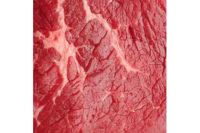Regulations & Legislation
FSIS clarifies, expands sampling eligibility for raw beef products

On Aug. 13, 2014, the Food Safety and Inspection Service (FSIS) issued Notice 39-14 titled: “Clarification and Expansion of Sampling Eligibility Criteria for the Routine Beef Manufacturing Trimmings (MT60) and Bench Trim (MT55) Sampling Programs” (http://bit.ly/DJ0914). This notice rescinds Notice 81-13 to provide clarification on what raw beef products should be sampled as beef manufacturing trimmings under sampling project MT60 and what raw beef products should be sampled as bench trim under MT55.
In determining the products FSIS will sample under each program, the establishment should first determine whether a per serule applies. If not, FSIS sets out a two-part criteria to determine the appropriate sampling project.
Per se Rules: Under the Notice, there are certain per se rules that cover many questions arising from the sampling projects:
- The same unaltered product cannot be subject to sampling under both MT60 and MT55;
- Products subject to sampling as “other raw ground beef components” under MT54 cannot be subject to sampling under either MT60 or MT55;
- Products to receive a full lethality process at a Federally inspected establishment are not to be sampled; and
- Finished non-intact or ground products are not to be sampled under MT60 or MT55.
Two-Part Criteria: If the per se rules above do not resolve the sampling question, the agency articulates a two-part criteria to determine whether to sample raw beef products and under what program:
- Was the raw beef product derived from animals slaughtered on site or was the product purchased (source), and
- Has the establishment designated the product for non-intact use (intent)?
On Source, MT60 is limited to product derived from animals slaughtered on site. If the slaughter establishment receives product that was slaughtered elsewhere, those raw materials are sampled under MT55. If an establishment does not slaughter at all, it can only be sampled under MT55, not MT60.
On Intent, in determining whether to sample under MT60, the slaughter establishment’s intent governs. If the slaughter establishment intends that the product be used for ground or other non-intact, it is subject to sampling under MT60 and should not be sampled as bench trim under MT55 at any location downstream.
Each slaughter establishment should identify which products are not intended for non-intact use. Beyond designating intended use in the HACCP plan, the slaughter establishments need to convey the intended use to purchasers.
According to the Notice, the slaughter establishment needs to identify “controls to ensure product is used as intended. A control can include a letter of intended use and a reference to the producing slaughter establishment’s letter of intended use on bills of lading.”
According to the FSIS Traceback Notice: “Many slaughter establishments maintain information on their Web sites or provide information to receiving establishments explaining that this product is not intended for grinding or use in other non-intact, raw product.” 79 Fed. Reg. 47,420, col. 2 (August 13, 2014).
A purchaser of beef for use in raw ground or other non-intact products should know the slaughter establishment’s intent so it can properly include the receipt of the beef in its HACCP plan.
Positives and Regulatory Actions:
For MT60 positives, the “lot” represented by the sample is determined by the slaughter establishment’s program, in most cases, the lot will be defined by the establishment’s sampling plan.
For MT55 positives, the “lot” implicated by the result can be limited to the individual product. According to FSIS: “the materials sampled as bench trim were not lotted like beef manufacturing trimmings at the slaughter establishment. In addition, each individual bench trim component is independent of another unless components are commingled at the further processing establishment.”
In all cases, FSIS will conduct at both the supplying and receiving establishments: (1) a directed HACCP verification task for the specific production lot that tested positive, (2) a directed Sanitation SOP task to review the records for the day(s) the product was produced, and, for the slaughter establishment, (3) a directed Beef Sanitary Dressing task. In addition, FSIS would conduct follow-up sampling.
In sum, Notice 39-14 should alleviate the concerns raised by the prior FSIS Notice on bench trim and help ensure the proper selection of samples for each project.
Looking for a reprint of this article?
From high-res PDFs to custom plaques, order your copy today!









